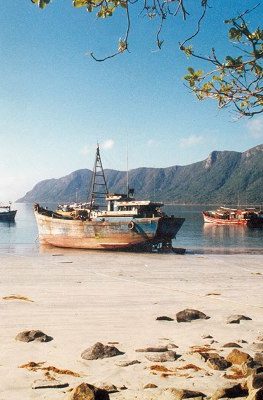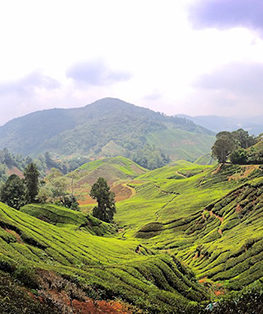Published on October 26, 2017

Redang Island, Malaysia. Image courtesy of Tourism Malaysia.
There’s no denying the mass appeal of Bangkok, Siem Reap and Singapore for travelers to Southeast Asia, but not everybody wants to follow the herd.
Sometimes you want to go where nobody else goes – the places not listed in backpacker districts’ itineraries, corners of Southeast Asia where you’ll be one of a very few visiting foreigners.
We asked three different travel bloggers to reveal the “secret” places they’ve long held to their chest. Their answers take us to the less-known east coast of Malaysia, the highlands of Papua in Indonesia, and a mysterious island in the Philippines.
East Coast Allure: Malaysia’s Redang Island
The Redang archipelago off Malaysia’s Terengganu state can be a challenge to get to, but “it’s difficult to get to for good reasons,” says food and travel writer Cat Lin, the blogger behind For Two, Please. “Its remote location allows the island to preserve its unspoiled beauty.”
If you can make one of the morning-only ferries from Kuala Terengganu, upon getting off the boat you’ll find yourself in the bubble that is Pulau Redang. “The scenery is mesmerizing and enchanting,” Cat tells us. “You will lose the sense of time. It is a place where you can truly disconnect from the world and fully immerse yourselves in nature.”
The island’s biggest draw – its white sand beach – has few equals in more popular beaches elsewhere. “I’ve never seen water so clear and sand so powdery white until I visited Redang,” Cat recalls. “Under the water, we were constantly surrounded by a large array of sea life and corals. The best part was that we didn’t need to dive deep to see these marine creatures!”
Most of the island’s resorts are located right on the beach – “you can go snorkeling and diving right outside your hotel!” Cat says. Beyond the beach, trekking is also on the agenda for visitors – “you might encounter monkeys, monitor lizards, bats and some other rare animals,” Cat explains.
The intense monsoons on Malaysia’s east coast should be factored into your visit, Cat warns – “most resorts on Redang island are closed from November to March during the monsoon season, so don’t plan a trip during this period.”

Papuans at Wamena, Indonesia. Image courtesy of Indonesia Ministry of Tourism.
Roughing it in Papua: Indonesia’s Baliem Valley
When talk drifts to hiking up Indonesia’s mountains, most travelers bring up the volcanoes on Java or the highland temples in Bali; the western half of Papua Island hardly comes up. But Bruno and Patricia, the French-American couple behind Ze Wandering Frogs, are hardly your average traveler.
“’Trekking in Papua’ sounded like a dream for the adventure travel fellows that we are,” the “Frogs” explained. “Papua was high on our travel plan so finding a hiking trail in Papua led us to the Baliem Valley.”
Bruno and Patricia stopped in Papua as part of the round-the-world trip, and commenced a hike that took eight days to cross between Wamena and Angurruk, “through villages as well as the jungle,” they explained. “We stayed in local guesthouses and men’s house, sleeping on the floor, and sometimes with the local villagers. In the jungle, we slept under temporary shelter and under a cliff-hanging rock.”
The scenery was well worth the effort. “This Baliem Valley to Yalimo country trail took us through steep valleys, traditional Papua villages, thick jungle, kids playing, villagers working in their fields, hanging bridges, women carrying their weights,” the Frogs recall. “Just epic landscapes and people!”
Baliem Valley is off-the-beaten-path for a reason – you need to be in top physical form to even attempt the trail. “Due to the steepness of trails, mostly unmaintained, the remoteness of the area, and the duration of the trail, it is recommended to be in great hiking shape and has good trekking experience,” the Frogs warn.
“Moreover, be ready to have to pay attention to your steps every second of every day,” they add. “The trail is mentally challenging as a second of inattention can get you to twist your ankle in a hole, slip over a wet log, or see you stumble over the cliff.”
You can read about the Frogs’ Baliem Valley hike in detail here.

Cambugahay Falls, Siquijor, Philippines. Image © Harry Fozzard/Creative Commons
That Old Black Magic: Philippines’ Siquijor Island
The Philippine island of Siquijor, Where Sidewalks End‘s Ian Ord tells us, “is said to be a bit haunted.”
Some new friends in Cebu (where he had been visiting) had told him of Siquijor, but advised him to stay away, due to Siquijor’s “shamans and witchdoctors practicing both white and black magic there. That piqued my intrigue even more and I knew I had to go!”
First-time visitors like Ian run through a list of things to do in Siquijor – Ian rented a scooter to take the list head-on. “I visited some of the beautiful waterfalls with their gorgeous milky aquamarine colour flowing over them,” Ian explains. “I did a bit of snorkelling and spelunking while there too.”
Wherever he went, magic was never far away in Siquijor. “There was an ancient mystic tree said to have magic properties to it, with some fish in a pond surrounding it which give you a sort of natural fish spa nibbling at your toes,” Ian recalls.
“However, the highlight of Siquijor was of course visiting the ‘voodoo’ ladies in the centre of the island up in the mountains,” explains Ian. The companion Ian brought to the shaman was treated for her alleged allergies, with blankets and incense lit under the chair – “[she] performed some chants, mild massaging, and then a final blessing,” Ian says. “She said that would help with her allergies, though best to avoid them when possible.”
True believers in magic should know that Siquijor’s magicians practice both on the light and dark side, Ian warns. “[There are] good shamans, and the more negatively focused witchdoctors or witches who tend to cast curses rather than enchantments,” he tells us. “Be careful who you visit if you do decide to see one of the shamans… or you may end up with the opposite results of what you were hoping for!”
* * * *
Cat Lin’s blog For Two, Please has the latest on her adventures traveling with her husband. Follow Cat on social media: Facebook, Instagram and Twitter.
Stay abreast of Bruno and Patricia’s adventures on their site Ze Wandering Frogs, or do the same on their social media profiles: Facebook, Twitter and Instagram.
Ian Ord is one of several travelers managing Where Sidewalks End; follow this site on Facebook,






